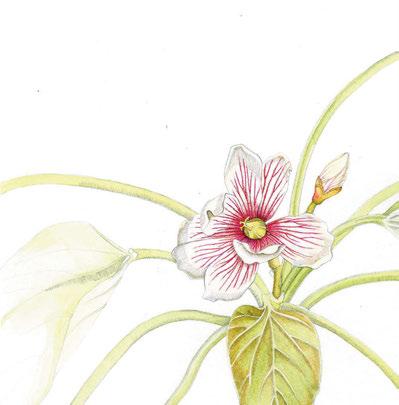
3 minute read
Just one plant
justone Plant
Iby TONY AVENT I WAS FIRST INTRODUCED TO ALEURITES FORDII (also known as Vernicia fordii) through the wood sealer called Tung oil, which is made om the plant. at was long before I met Aleurit fordii in person. I knew about Tung oil because as a young child, I watched far too many episodes of Public Television’s Woodwright’s Shop. e host, Roy Underhill, made it seem simple to make one’s own furniture, so it was easy for me to delude myself that I had a modicum of talent in this area. Before I came to my senses, I became familiar with the joy of rubbing wood down with Tung oil while channeling my inner Mr. Miyagi. I spent hours working with it – brush on, sand o , brush on, sand o – before fi nally realizing that working with dead wood wasn’t my strong suit. But I never forgot Tung oil. Made by pressing the uit of the Tung tree, the stu has been used in Chinese cultures for over 2,000 years – as an ink for printing, and as a waterproof sealer for early wood boats. During World War II, the Chinese even discovered a way to produce motor fuel om Tung oil, although at the time, the process took too long and was too expensive to be economically feasible. In the years since, the demand for Tung oil has fl uctuated. You can fi nd abandoned Tung oil plantations throughout the Gulf coast. Unfortunately, repeated hurricanes kept the in-
Advertisement

TREE of hearts
dustry om expanding, so today, over 80 percent of Tung oil still comes om China. Today, it is prized for its wet-look fi nish and water-resistant durability when applied to both wood and granite countertops.
Growing Tung
Years later, when I began looking for interesting trees for my new garden, I remembered Tung oil and thought it would be interesting to try growing my own. I fi nally located seed, and although they all germinated and grew well a er planting, they also died over winter. More research helped me understand why I failed: e trees I planted were native to tropical and subtropical areas of Southern China, Burma, and Vietnam. I had given up on ever growing Tung oil until I was chatting with Frank Galloway, a plantsman om Bolivia, N.C., who told me of a tree at the New Hanover County Arboretum that had survived 0 degrees Farenheit without damage. Frank is a keen plantsman, so although I was skeptical, I planted a handful of seed he shared. Up they sprouted, and by 2001, my plant was large enough to go into the ground. Fourteen years later, we enjoy our amazing 30-foot tall specimen. It has been untouched by any of our recent cold winters. I love so many things about our Tung oil tree, it’s hard to know where to start. e branch architecture is very angular, somewhat reminiscent of a Chinese parasol tree. Starting in early May, its large, glossy, tropical-looking, heart-shaped leaves (Tung is Chinese for heart) emerge and clothe the upper branches. Before the leaves emerge, however, bare stems are topped by clusters of large peachy-orange, deliciously agrant fl owers that remind me of a plumeria (Hawaiian lei fl ower). A full-size Tung oil tree in full fl ower is an amazing sight. In addition to the fl owers, Christmas-ornament-sized uit dangle om its branches om August through October, like a tree fi lled with pendant fi gs. It’s fi ne to admire the uits or use them to make Tung oil, but ingestion is not recommended unless you’re looking for an excuse to miss a couple days of work with a bout of diarrhea. If you’re interested in seed, drop by our fall open garden days and we’ll be glad to share some.



